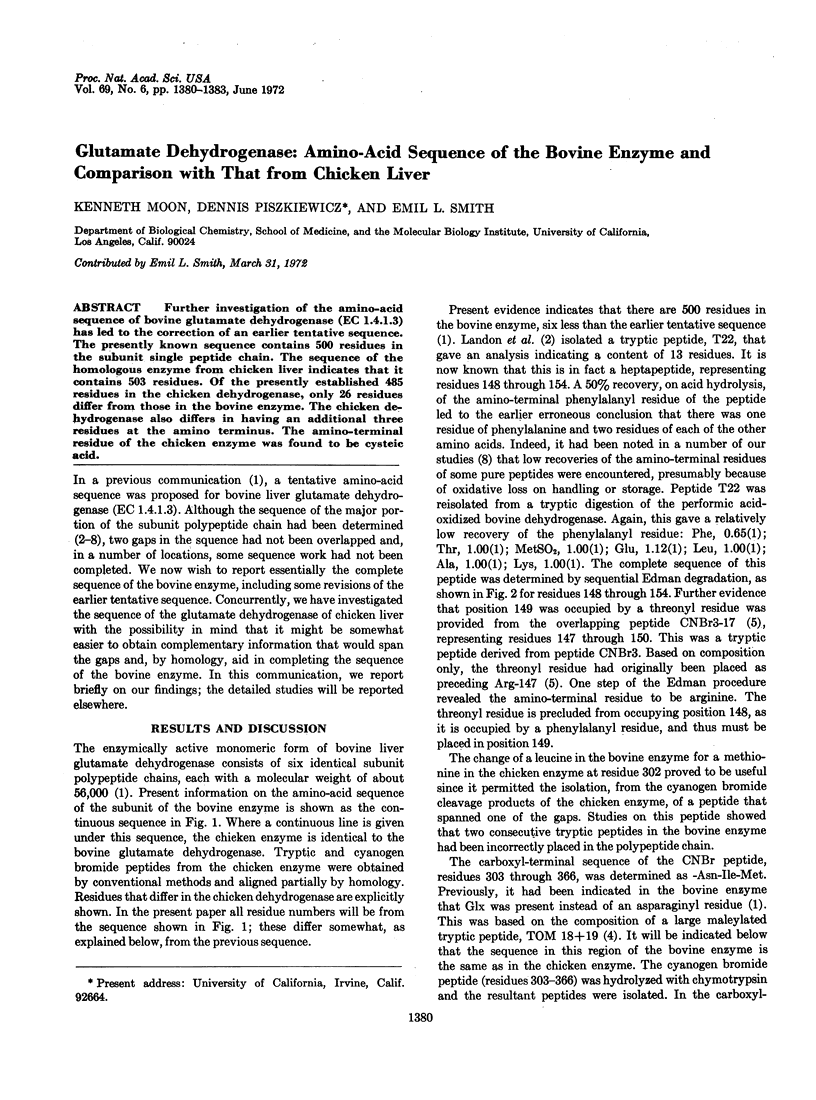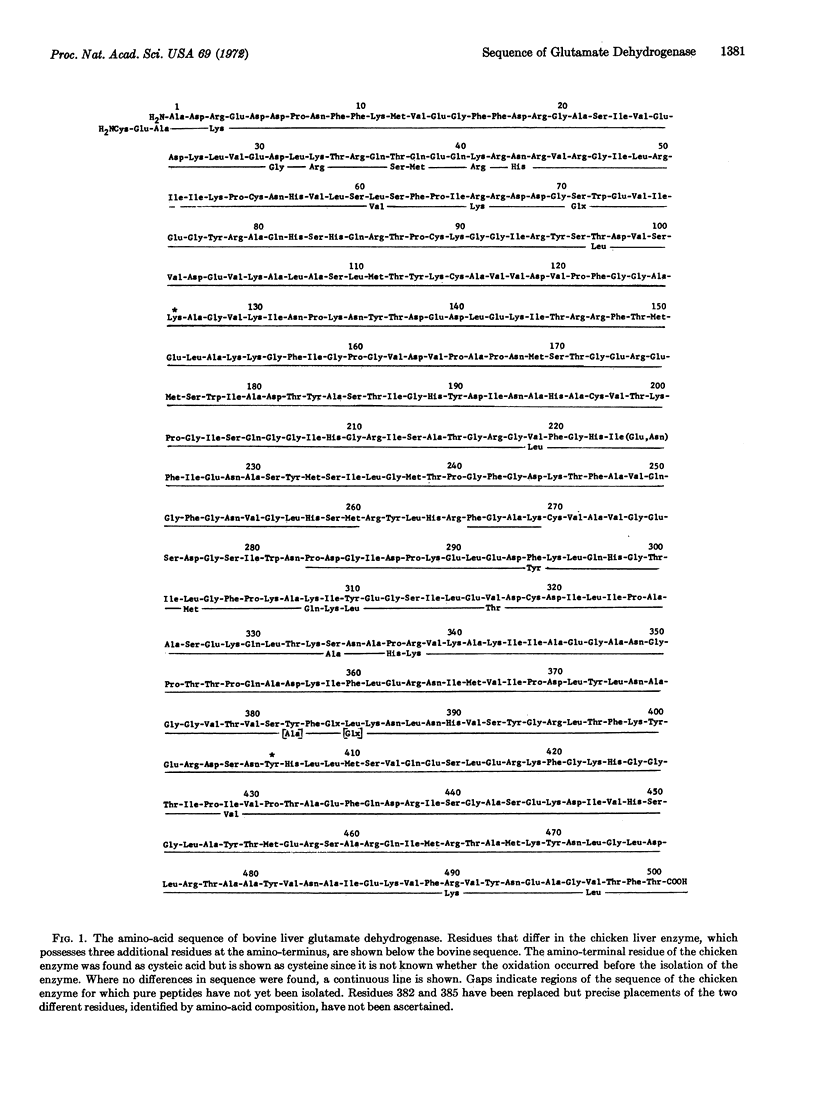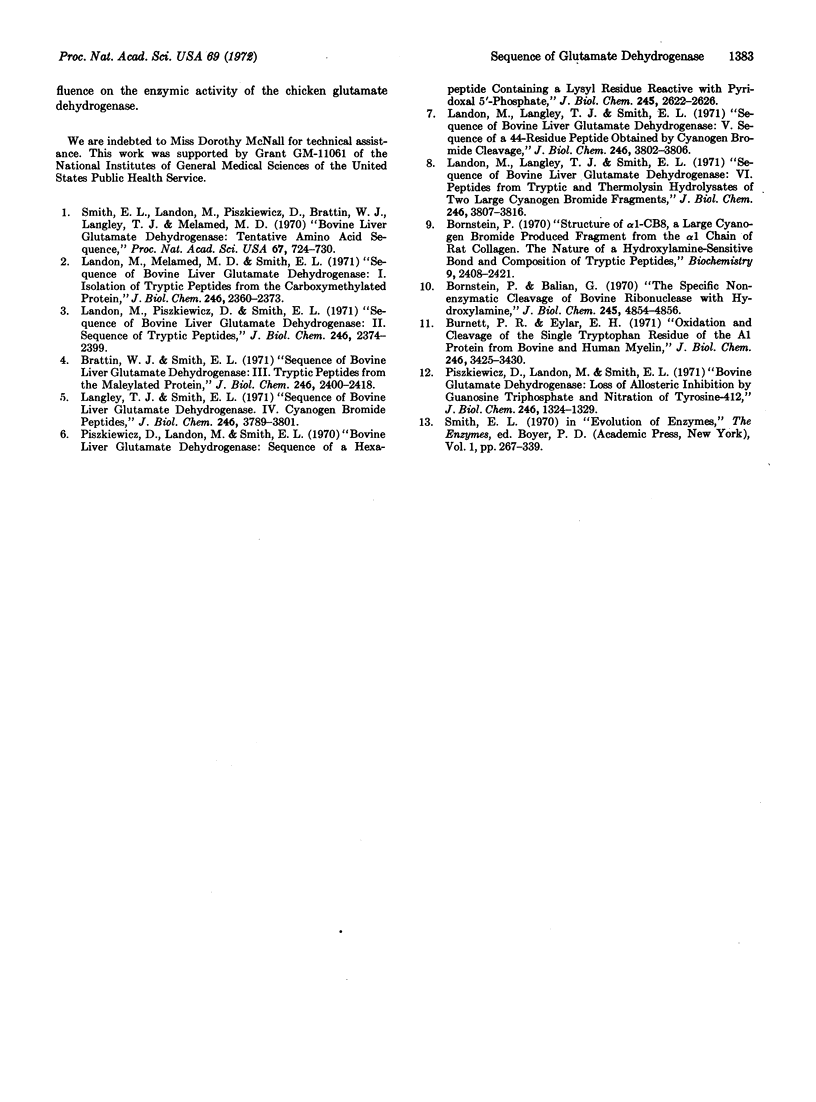Abstract
Further investigation of the amino-acid sequence of bovine glutamate dehydrogenase (EC 1.4.1.3) has led to the correction of an earlier tentative sequence. The presently known sequence contains 500 residues in the subunit single peptide chain. The sequence of the homologous enzyme from chicken liver indicates that it contains 503 residues. Of the presently established 485 residues in the chicken dehydrogenase, only 26 residues differ from those in the bovine enzyme. The chicken dehydrogenase also differs in having an additional three residues at the amino terminus. The amino-terminal residue of the chicken enzyme was found to be cysteic acid.
Full text
PDF



Selected References
These references are in PubMed. This may not be the complete list of references from this article.
- Bornstein P., Balian G. The specific nonenzymatic cleavage of bovine ribonuclease with hydroxylamine. J Biol Chem. 1970 Sep 25;245(18):4854–4856. [PubMed] [Google Scholar]
- Bornstein P. Structure of alpha-1-CB8, a large cyanogen bromide produced fragment from the alpha-1 chain of rat collagen. The nature of a hydroxylamine-sensitive bond and composition of tryptic peptides. Biochemistry. 1970 Jun 9;9(12):2408–2421. doi: 10.1021/bi00814a004. [DOI] [PubMed] [Google Scholar]
- Brattin W. J., Jr, Smith E. L. Sequence of bovine liver glutamate dehydrogenase. 3. Tryptic peptides from the maleylated protein. J Biol Chem. 1971 Apr 25;246(8):2400–2418. [PubMed] [Google Scholar]
- Burnett P. R., Eylar E. H. Allergic encephalomyelitis. Oxidation and cleavage of the single tryptophan residue of the A1 protein from bovine and human myelin. J Biol Chem. 1971 May 25;246(10):3425–3430. [PubMed] [Google Scholar]
- Landon M., Langley T. J., Smith E. L. Sequence of bovine liver glutamate dehydrogenase. V. Sequence of a 44-residue peptide obtained by cyanogen bromide cleavage. J Biol Chem. 1971 Jun 25;246(12):3802–3806. [PubMed] [Google Scholar]
- Landon M., Langley T. J., Smith E. L. Sequence of bovine liver glutamate dehydrogenase. VI. Peptides from tryptic and thermolysin hydrolysates of two large cyanogen bromide fragments. J Biol Chem. 1971 Jun 25;246(12):3807–3816. [PubMed] [Google Scholar]
- Landon M., Melamed M. D., Smith E. L. Sequence of bovine liver glutamate dehydrogenase. I. Isolation of tryptic peptides from the carboxymethylated protein. J Biol Chem. 1971 Apr 25;246(8):2360–2373. [PubMed] [Google Scholar]
- Landon M., Piszkiewicz D., Smith E. L. Sequence of bovine liver glutamate dehydrogenase. II. Sequences of tryptic peptides. J Biol Chem. 1971 Apr 25;246(8):2374–2399. [PubMed] [Google Scholar]
- Langley T. J., Smith E. L. Sequence of bovine liver glutamate dehydrogenase. IV. Cyanogen bromide peptides. J Biol Chem. 1971 Jun 25;246(12):3789–3801. [PubMed] [Google Scholar]
- Piszkiewicz D., Landon M., Smith E. L. Bovine glutamate dehydrogenase. Loss of allosteric inhibition by guanosine triphosphate and nitration of tyrosine-412. J Biol Chem. 1971 Mar 10;246(5):1324–1329. [PubMed] [Google Scholar]
- Piszkiewicz D., Landon M., Smith E. L. Bovine liver flutamate dehydrogenase. Sequence of a hexadecapeptide containing a lysyl residue reactive with pyridoxal 5'-phosphate. J Biol Chem. 1970 May 25;245(10):2622–2626. [PubMed] [Google Scholar]
- Smith E. L., Landon M., Piszkiewicz D., Brattin W. J., Langley T. J., Melamed M. D. Bovine liver glutamate dehydrogenase: tentative amino acid sequence; identification of a reactive lysine; nitration of a specific tyrosine and loss of allosteric inhibition by guanosine triphosphate. Proc Natl Acad Sci U S A. 1970 Oct;67(2):724–730. doi: 10.1073/pnas.67.2.724. [DOI] [PMC free article] [PubMed] [Google Scholar]


